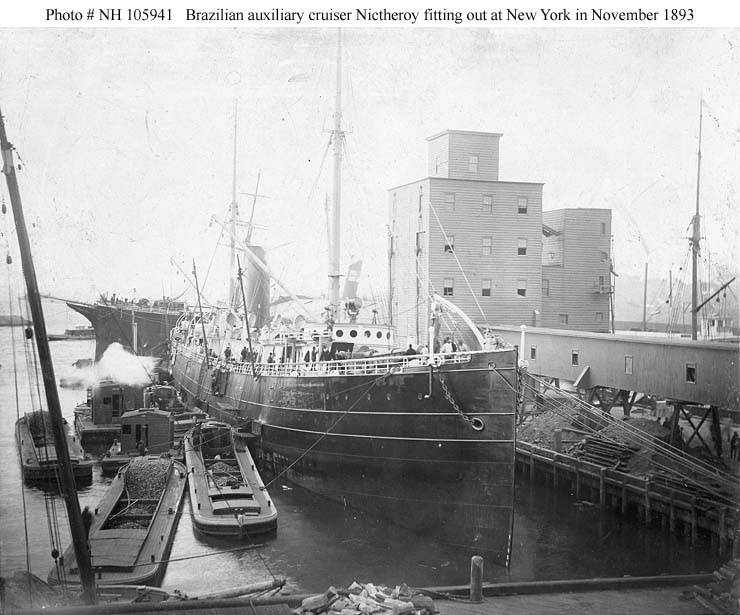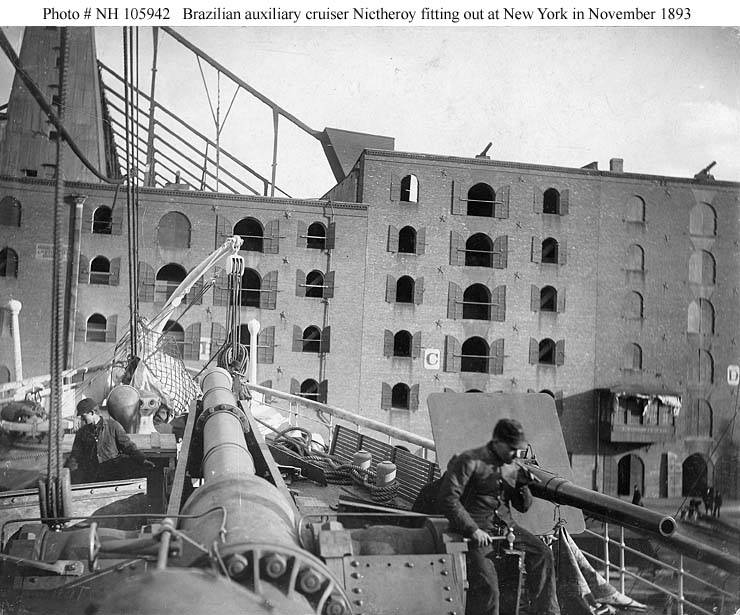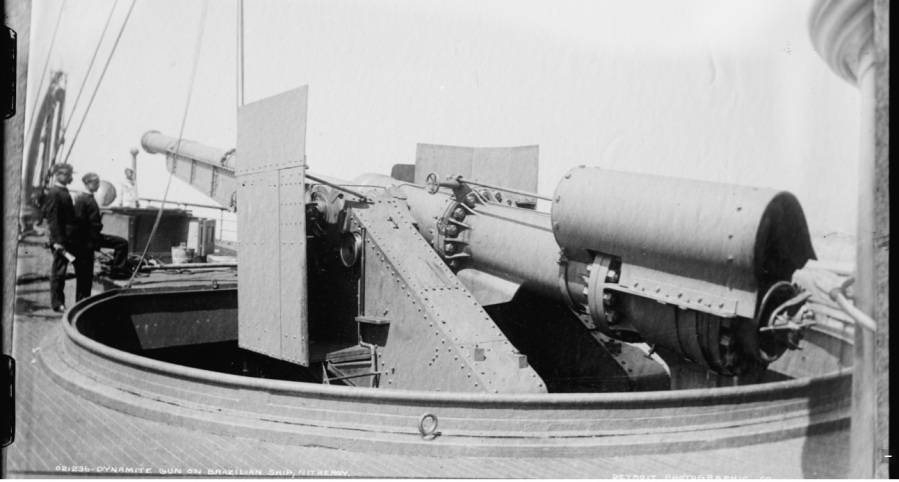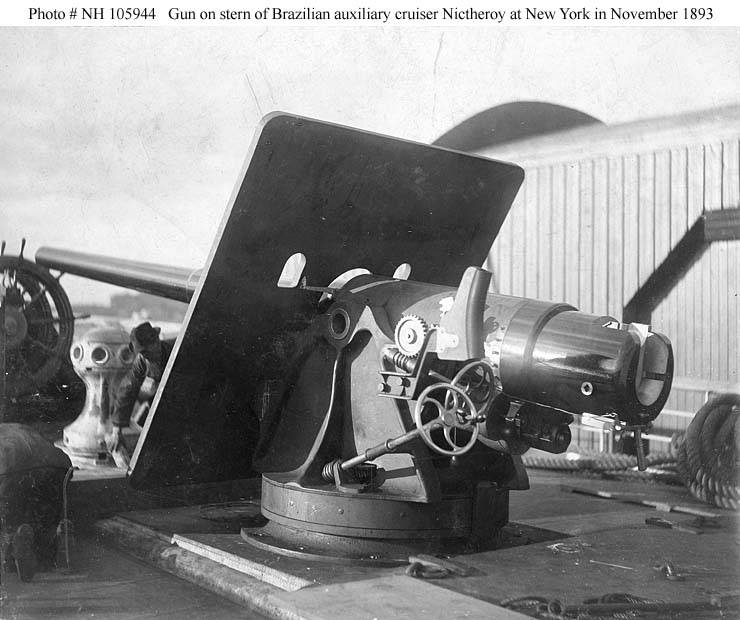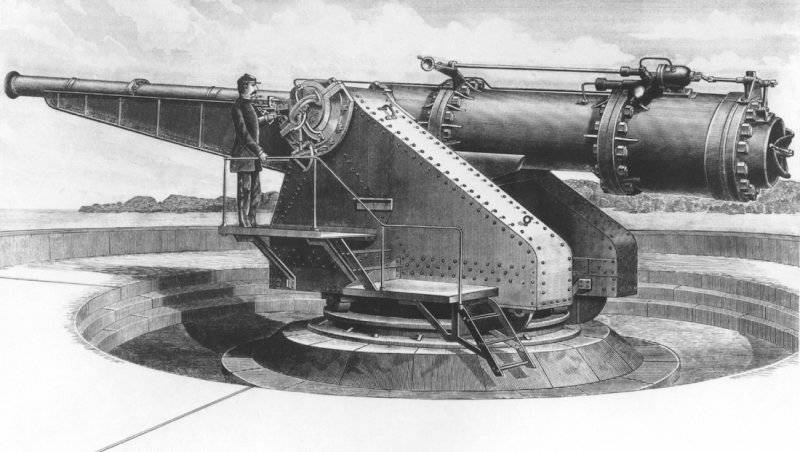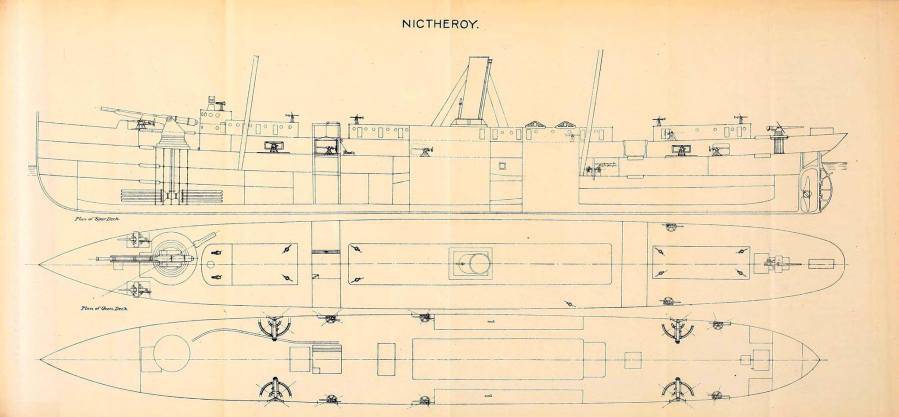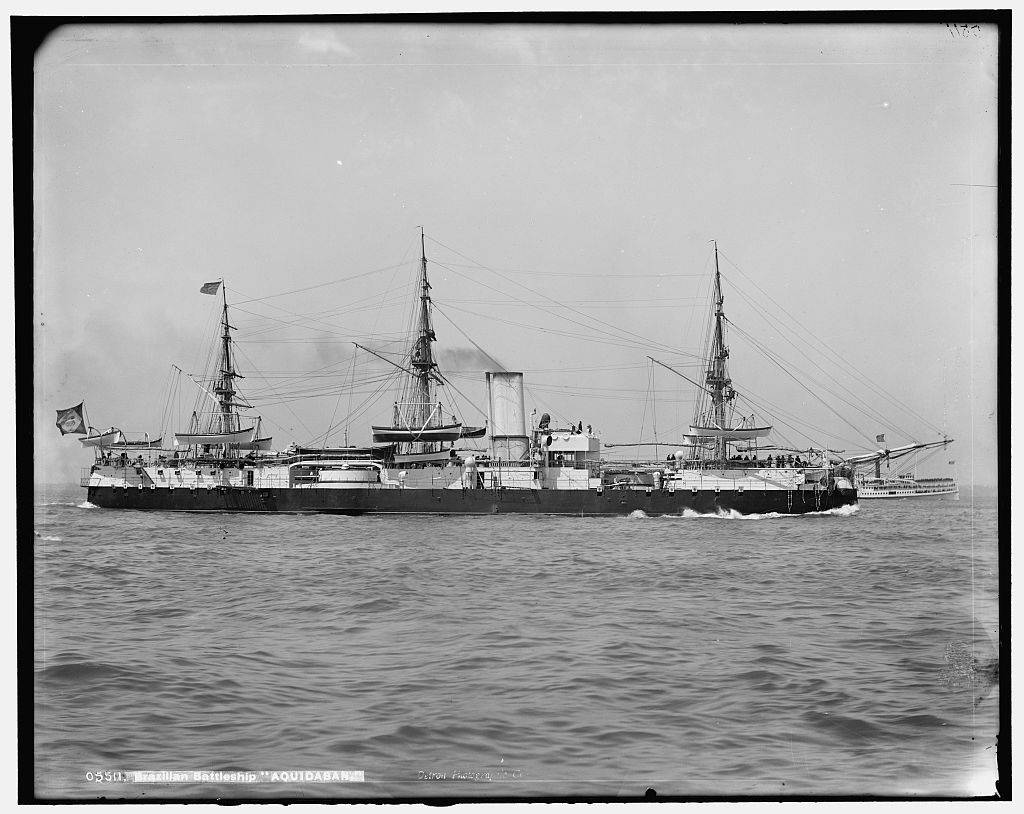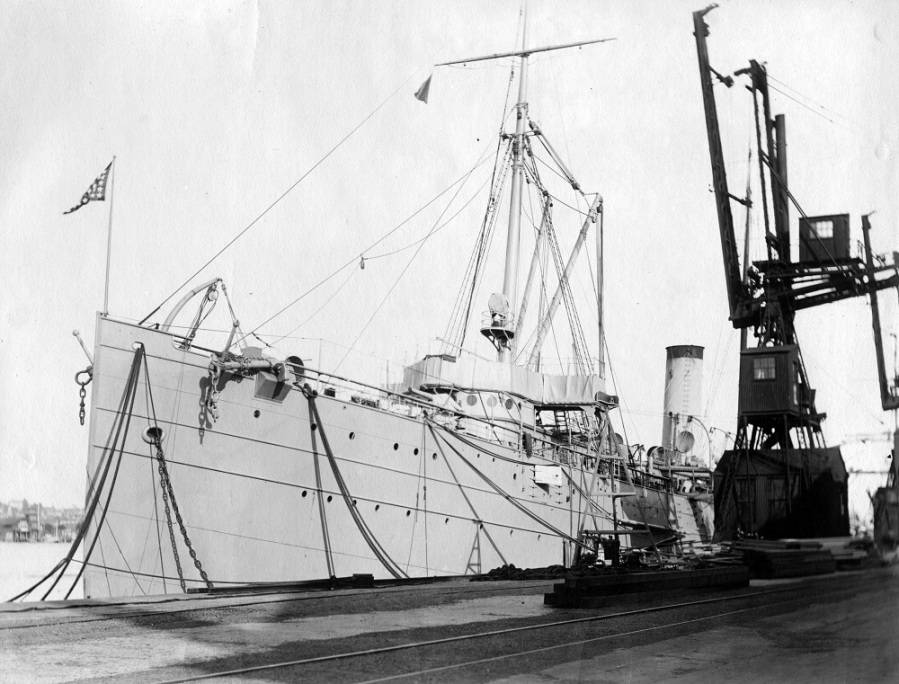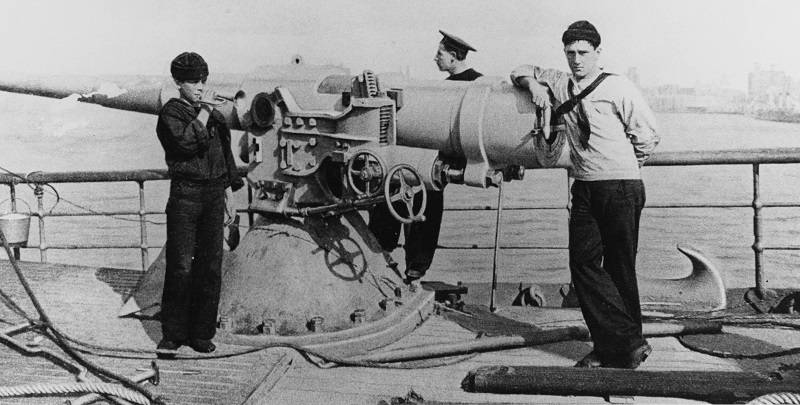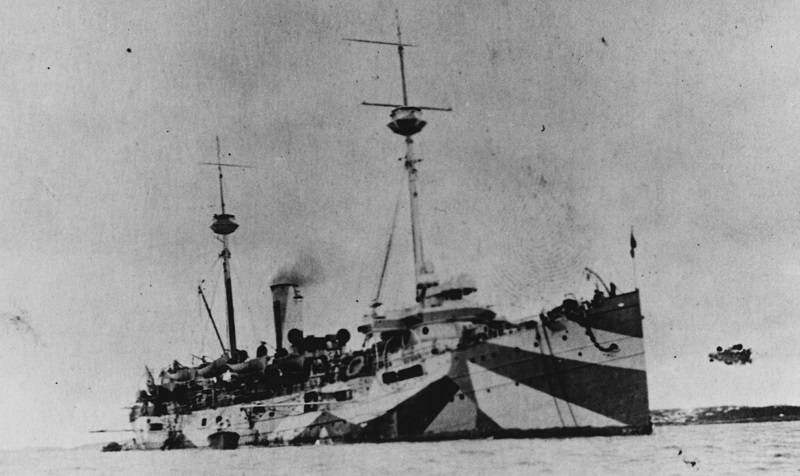lordroel
Administrator
Posts: 68,137 
Likes: 49,520
|
Post by lordroel on Apr 2, 2022 6:20:15 GMT
April 2nd 1898
United States - Journal Of Secretary Of The Navy John D. Long
Washington, D.C., Saturday, April 2nd, 1898.
— ; —
Owing to Mr. Snyder’s (1) illness, and my own engrossment in Departmental matters, have not written anything for my journal since the 20th March. It has been a period of incessant activity and pressure. The report of the Court of Inquiry upon the Maine disaster has come in, to the effect that the explosion was from the outside and, therefore, willful and malicious. The report, however, is unable to fix the responsibility upon any person or persons. The result is intense feeling in Congress. It looks very much as if war might be precipitated without sufficient previous deliberation and, perhaps, without exhausting all means of peaceable settlement. The President (2) is under a weight which is almost more than man can bear, and, for the last few days, has shown a good deal of weariness and nervous strain
Footnote 1: Snyder was Long’s secretary at the Navy Department.
Footnote 2: President William McKinley.
|
|
miletus12
Squadron vice admiral
To get yourself lost, just follow the signs.
Posts: 7,470 
Likes: 4,295
|
Post by miletus12 on Apr 2, 2022 14:38:17 GMT
Official Report of the Naval Court of Inquiry into the loss of the Battleship MAINE (Sampson Board) Comments: 1. The testimony and investigations have been numerous and all over the place: a. Spanish forensics was fair to good, based on external circumstantial evidence; but incomplete due to US objections that disallowed Spanish authorities from examining the physical interior of the wreck. The reason was not jingoism. The USS Maine contained secret technology that the US did not want the Europeans to know about. Essentially shell handling and torpedo launch systems were at issue. b. I do not know what paintjob the Sampson Board was ordered to whitecoat the crew of the USS Maine, but the crew were known to have failed a port safety inspection prior to the Havana deployment which noted numerous ship-keeping errors directly connected to operational cleanliness of fuel (coal) and volatiles (paints, varnishes, and oils.). The automatic fire suppression system installed in the coal bunkers (Overhead sprinklers with melt out sprayer plug heads stolen from the French as a safety feature for the coal bunkers.) was never checked or tested. c. The keel was bent into an inverted V. Whether that was due to a primary water hammer from a mine or caused by a bottom reflected shock wave is impossible to determine down to the present. It is true that the USS Maine was forced to moor outside and adjacent to a harbor defense minefield by the Spanish authorities. This minefield was of the Bustamente command / or contact detonated type. One of those mines could have broken loose and drifted from its moorings. d. The presence or absence of dead fish could never be reliably established since the tides carried away evidence. e. The water column or lack of seems to be a point that is disputed. Not all ship minings produce a water column. f. The two explosions hypothesis could be either a mine or coal bunker as the first cause, but definitely the magazines adjacent to the hull rupture site is the second. g. On board ship sabotage has never been considered. It is too late now to forensically examine for this possibility. =========================================================== My opinion is of two parts. a. First the Spanish admiral commanding Havanna was a crazed lunatic who wanted to start a war with the United States. b. Captain Philip R. Alger of the USN was a leading world authority on ordnance and the handling of fuel and the dangers thereof in storage and use. He concluded a coal fire and methane explosion set off the 6 inch propellant in the adjacent magazines. One can hypothesize anything from the fragmentary and incomplete evidence. US authorities did not jump to an automatic conclusion that the USS Maine was blown up by a Spanish act of war. The Sampson board was, for the time, surprisingly honest for what it was and did. They jumped to a conclusion based on explosive forensics which is all that they had. The Rickover Investigation agreed with Captain Alger that it was a coal fire and methane gas explosion. The National Geographic investigation found that a crater blown into the Havanna harbor bottom "could have" been the result of a mining event, but read above where I speculated a reflected shock wave could have bent USS Maine's keel. =========================================================================================== Cuban and Russian communist "alleged historians" have raised the idea that the US blew their own ship up to create an incident. This goes against the strategic correlation of forces and the geopolitics of the McKinley administration as well as defies common sense. The US was preparing to fight a war, if necessary, but US planning for Cuba at the time was based on the 1900 timeframe when the USN would be actually strong enough to handle the Armada. In 1898, the correlation of forces as of February, as ONI estimated, actually favored the Spanish. The experts did not like the odds. =========================================================================================== My belief is the coal fire hypothesis. Captain Sigsbee was a sloppy captain who ran a lax and sloppy ship. His past record indicated that he did not enforce tight discipline or maintain standards in either safety or combat efficiency. He let a situation develop where a coal fire could outbreak and a magazine explosion could be the result.
|
|
lordroel
Administrator
Posts: 68,137 
Likes: 49,520
|
Post by lordroel on Apr 3, 2022 7:24:11 GMT
April 3rd 1898
Cebu, Philippines
An insurrection against Spanish rule breaks out on the island of Cebu in the Philippines.
|
|
lordroel
Administrator
Posts: 68,137 
Likes: 49,520
|
Post by lordroel on Apr 4, 2022 2:58:57 GMT
April 4th 1898
United States
President McKinley's war message to Congress is delayed to April 6 and then April 11 after Spain submits a new plan (short of armistice) for Cuban autonomy and US Consul-General Fitzhugh Lee in Havana asks for more time to evacuate Americans. Other factors contributing to the delay include news that the Spanish Atlantic Squadron is still near the Cape Verde Islands and that US Attorney General John W. Griggs needs more time to draft McKinley's message.
The New York Journal issued a million copy press run dedicated to the war in Cuba. The newspaper calls for the immediate US entry into war with Spain.
Philippines: Battle of Tres de Abril
Philippine rebels drive the Governor, General Montero, and his Spanish volunteers into Fort San Pedro and take control of Cebu City but when the Spanish gunboat Maria Cristina opened fire, the Philippine rebels are force to retreat to the Chinese quarter of Lutao.
Callao, Peru
Battleship USS Oregon arrived in Callao, after traveling a distance of 4,112 miles in sixteen days. The only relaxation the crew experienced during this first leg of the dash was the traditional visit of King Neptune as the vessel crossed the equator. However, throughout the run, the ship's band was given permission to perform evening concerts to entertain the crew. At Callao, a friendly port, the crew worked furiously to replenish coal and supplies, with extra watches placed as a guard against any Spanish sympathizers who might attempt sabotage. The vessel was coaled from lighters in the safety of the center of the harbor rather than from the docks.
While in Callao, Captain Charles Clark is informed by cable from Washington that the Spanish torpedo boat, Temerario has left Montevideo, Uruguay, and may be stalking the Oregon. Fear of torpedo boats ran high, since, for the first time in history, a small vessel with torpedoes could attack a large vessel and sink her through the use of the newly invented torpedo. The Oregon's crew would have to be on their guard against a torpedo attack, which could occur at any time and with little warning.
Hong Kong - Commodore George Dewey, Commander, Asiatic Station, To Secretary Of The Navy John D. Long
Hongkong, April 4, 1898.
Secretary of the Navy, Washington:
I have chartered the British steamer Nanshan, having over 3,000 tons of coal now on board. Before the outbreak of hostilities can and would purchase this steamer. I request the earliest information in order to conclude arrangements. Can not be made after the outbreak of hostilities.
United States - Secretary Of The Navy John D. Long To Commodore George Dewey, Commander, Asiatic Station
Washington, April 4, 1898.
Dewey, Hongkong:
Can you purchase immediately supply steamer? What will be the cost of?.
Long
United States - Commodore George Dewey, Commander, Asiatic Station, To Secretary Of The Navy John D. Long
Washington, 4/5/98
DEWEY, Hong Kong, China.
Revenue cutter McCulloch, now at Singapore has been ordered to proceed to Hong Kong and report to you for duty in the squadron under your command.
Long
|
|
lordroel
Administrator
Posts: 68,137 
Likes: 49,520
|
Post by lordroel on Apr 5, 2022 2:50:57 GMT
April 5th 1898
United States - Secretary Of The Navy John D. Long To Commodore George Dewey, Commander, Asiatic Station
From Secretary of the Navy
To COM’D’R-IN-CHIEF
Date April 5, 1898.
Subject Purchase auxiliaries.
War may be declared.
Purchase immediately Nanshan one more vessel for supply.
Charge special appropriation.
Send the receipt to the Department.
Enlist for special service if possible one year unless sooner discharged the crew.
Detach and order to assume command of each and officer.
Arm if possible.
War may be declared.
Condition very critical.
|
|
lordroel
Administrator
Posts: 68,137 
Likes: 49,520
|
Post by lordroel on Apr 6, 2022 2:58:34 GMT
April 6th 1898
Vatican
Pope Leo XIII asked US President McKinley not to go to war.
United States - Secretary Of The Navy John D. Long To Commodore William T. Sampson, Commander, North Atlantic Station
LETTER
CONFIDENTIAL Washington, April 6, 1898
Sir:
In the event of hostilities with Spain,the Department wishes you to do all in your power to capture or destroy the Spanish war vessels in West Indian waters, including the small gunboats which are stationed along the coast of Cuba.
2. The Department does not wish the vessels of your squadron to be exposed to the fire of the batteries of Havana,Santiago de Cuba,or other strongly fortified ports in Cuba, unless the more formidable Spanish vessels should take refuge within those harbors. Even in this case,the Department would suggest that a rigid blockade and employment of our torpedo boats might accomplish the desired object,viz., the destruction of the enemy’s vessels,without subjecting unnecessarily our own men-of-war to the fire of the land batteries.
There are two reasons for this:
1st: There may be no United States troops to occupy any captured stronghold,or to protect from riot and arson,until after the dry season begins,about the first of October.
2nd: The lack of docking facilities makes it particularly desirable that our vessels should not be crippled before the capture or destruction of Spain’s most formidable vessels.
3. The Department further desires that,in case of war,you will maintain a strict blockade of Cuba,particularly at the ports of Havana,Matanzas,and,if possible,of Santiago de Cuba,Manzanillo and Cienfuegos. Such a blockade may cause the Spaniards to yield before the rainy season is over.
4. All prizes should be sent to Key West or other available United States ports for adjudication.
5. Should it be decided to furnish the insurgents with arms and ammunition,the Department suggests that Nuevitas and Puerto Padre would be the most suitable places to land them and establish communications with the Cuban forces.
6. Should the Department learn that the Spanish fleet had gone to Puerto Rico,it is possible that the Flying Squadron may be sent thither,in which case some of your vessels may be needed to reinforce that squadron.
7. The Department hopes to be able to cut the cable off Santiago de Cuba, even if it has to employ a special cable vessel for this purpose,and it also has under consideration the practicability of cutting the cable near Havana and connecting the end to one of the vessels of your command so that you can always be in communication with the Department. Whether or not this plan is feasible has not yet been determined. Please consider it.
8. The Department need not impress upon you the necessity for stringent sanitary regulations. It leaves this matter,as to details in regard to conducting operations to the Commander-in-Chief, in whose judgment it has the greatest confidence.
Wishing you every success,
Very respectfully,
John D. Long,
Secretary.
Hong Kong - Commodore George Dewey, Commander, Asiatic Station, To Secretary Of The Navy John D. Long
HongKong, April 6, 1898.
Secretary of the Navy, Washington, D.C.:
I have purchased Nanshan and I have engaged her crew. Will detail an officer for command. I have ordered three officers, 50 men from Monocacy to fill vacancies here. I hope to get another steamer (1) * * * The receipt of telegram April 6 acknowledged, to expedite delivery (2).
Dewey.
Footnote 1: Dewey purchased the Nanshan and the coal it carried in compliance with a 4 April 1898, order from Secretary Long. Long then ordered Dewey to purchase a second vessel and to crew and arm in anticipation of the coming conflict with Spain. Dewey chose to take 3 officers and 50 men from the gun-boat Monocacy, because the Civil War era steamer was believed to be ill-suited for combat in the Philippines. Furthermore, Dewey was ordered by Acting Secretary of the Navy Theodore Roosevelt to leave the Monocacy in coastal China in the event of any sortie to the Philippines.
Footnote 2: See: Long to Dewey, 4 April 1898.
United States - Secretary Of The Navy John D. Long To Captain Charles E. Clark
Translation:
Washington, April 6, 1898,
Oregon, Callao, Peru.
Proceed at once to Rio Janeiro or Montevideo. The Spanish torpedo boat Temerario is in Montevideo. Marietta has been ordered to proceed to Sandy Point Patagonia to arrange for coal. How many tons of coal will you require for Marietta and the Oregon to proceed together. Keep secret your destination. Keep secret this message.
Long
|
|
lordroel
Administrator
Posts: 68,137 
Likes: 49,520
|
Post by lordroel on Apr 7, 2022 2:52:08 GMT
April 7th 1898
United States
The ambassadors of the United Kingdom, Germany, France, Italy Austria-Hungary and Russia appeal US President McKinley for peace. President McKinley reply to them:
The Government of the United States recognizes the good will which has prompted the friendly communication of the representatives of Germany, Austria-Hungary, France, Great Britain, Italy, and Russia, as set forth in the address of your excellencies, and shares the hope therein expressed that the outcome of the situation in Cuba may be the maintenance of peace between the United States and Spain by affording the necessary guarantees for the re-establishment of order in the island, so terminating the chronic condition of disturbance there which so deeply injures the interests and menaces the tranquility of the American nation by the character and consequences of the struggle thus kept up at our doors, besides shocking its sentiment of humanity. The Government of the United States appreciates the humanitarian and disinterested character of the communication now made on behalf of the powers named, and for its part is confident that equal appreciation will be shown for its own earnest and unselfish endeavors to fulfill a duty to humanity by ending a situation the indefinite prolongation of which has become insufferable.
Philippines: Battle of Tres de Abril
500 men of the 73rd Native Regiment and Spanish cazadores arrive under the command of General Tejeiro, and with the cruiser Don Juan de Austria, forcing the Philippine rebels to retreat to San Nicolas.
|
|
lordroel
Administrator
Posts: 68,137 
Likes: 49,520
|
Post by lordroel on Apr 8, 2022 2:00:28 GMT
April 8th 1898
Singapore
Revenue Cutter USRC McCulloch which is her shakedown cruise, a voyage which began in Philadelphia and taking here via the Suez Canal and the Far East to her first duty station at San Francisco, California arrives at Singapore.
United States - Captain William T. Sampson, Commander, North Atlantic Station, To Secretary Of The Navy John D. Long
U.S.Flagship New York,1st Rate,
Key West, Florida,
April 8th,1898.
Sir:-
1. Referring to the Department’s telegram of the 2nd instant requesting my plan of operations,and my reply thereto,I have the honor to suggest to the Department in this connection as follows:-
2. It is highly important that the scheme of operations against the forces and possessions of Spain should be clearly and cogently laid down and thoroughly understood by all officers in position of command and responsibility. There are now,as I understand the situation,two squadrons ready for offensive operations; the one which I have the honor to command,and the Flying Squadron under the command of Commodore Schley. I request that I may be informed of the Department’s intentions and expectations as to the scope of action of the two forces,and especially as to the portion of the line of operations which is to be taken care of by the Flying Squadron.
3. The line of attack against Spain covers the distance from the western end of Cuba to Porto Rico (the islands held by Spain and the adjacent waters traversed by her fleet) and may extend into the Atlantic beyond Porto Rico for the purpose of intercepting her vessels of war coming from transatlantic ports;especially her torpedo Flotilla. Upon this line she has one strongly fortified port (Havana) and two heavy armored modern cruisers. These two factors are substantially all of a strictly military character with which we have at present to deal. My desire to attack Havana without delay has already been conveyed to the Department and I have asked for the return of the MASSACHUSETTS and the ordering here of the AMPHITRITE to aid in its reduction. I am in hourly expectation of the arrival of the PURITAN. With the battle ships and these monitors I should expect to speedily destroy its batteries and render the Cuban capital defenseless. With a smaller force I still hope to satisfactorily accomplish this,but there is a certainty about overwhelming force in war which renders its employment desirable. Should,however, the batteries of Havana prove to be unexpectedly strong,thereby rendering it inadvisable to push the attack to a conclusion,I shall at once substitute a close blockade of the port,which will be extended east and west to the smaller places.
4. As to the VISCAYA and OQUENDO. Those vessels have left Havana,and where they are at present is not known to me. They cannot operate without coal. Our object should therefore be to cut them off from all coal supply. The capture of Porto Rico and the destruction of its supplies of coal at one end of the line,and the effective blockade of Cuban ports at the other end would speedily put them in a very unpleasant predicament. The moment would soon arrive when they would be obliged to decide between returning to Spain or remaining upon the chances of fighting their way into a blockaded port,only,perhaps,to be surprised by a battleship. I think it may be assumed that under such circumstances with diminishing coal,they would not attempt to raid the Atlantic Coast,with the chance of being caught in a trap without means of escape.
5. My opinion that these cruisers should be steadily and relentlessly pursued,their supplies cut off,and no rest allowed them,is indicated in the foregoing. We have but three ships -the New York, TEXAS and BROOKLYN which are their equals in both speed and power. We have two others,the COLUMBIA and MINNEAPOLIS which are their superiors in speed,although not equal in power. Four of these vessels are in the Flying Squadron and these four could run down and capture the VISCAYA and OQUENDO or chase them out of the Cuban Atlantic. It is, I think safe to assume that this once accomplished,no vessels of Spain would again appear in these waters.
Very respectfully,
W.T. Sampson
Captain,Comdr.-in Chief,
U.S.Naval Force on North Atlantic Station.
|
|
lordroel
Administrator
Posts: 68,137 
Likes: 49,520
|
Post by lordroel on Apr 9, 2022 7:43:34 GMT
April 9th 1898
Spain
Spain agrees to the March 29 ultimatum's demand that it ask for an armistice with the Cuban rebels, but the McKinley administration says the concession comes too late.
Philippines
Spanish Army General Basilio Augustín becomes Governor-General of the Philippines. He creates a consultative assembly to avert open rebellion against Spain, but most Filipinos reject it as illegitimate. Emilio Aguinaldo establishes military organizations in each area under Filipino rebel control.
United States - Rear Admiral William T. Sampson, Commander, North Atlantic Station, To Secretary Of The Navy John D. Long
U.S. Flagship New York, 1st Rate.
Key West, Florida,
April 9, 1898.
My dear Mr. Secretary:--
I have received your confidential letter of April 6th (1).
2. I sympathize with all you say about guarding our big ships against a possibly serious loss, while the enemy’s fleet is still intact. At the same time I regard it as very important to strike quickly and strike hard as soon as hostilities commence. Havana is well defended by three or four batteries to the Eastward of the entrance, mounting guns from 6” to 12” calibre. On the Western side of the entrance there are three batteries, the guns varying in calibre from 6” to 12”, and two mortar batteries. All the batteries face seaward, and those to the West of the entrance are quite near the shore. All are open batteries, with heavy traverses between the guns. The guns and people who serve them are quite unprotected.
3. These batteries are well calculated to keep off a feet from seaward, which approaches to within a moderate distance of a few thousand yards. I do not think they are well placed to resist an attack, (for instance, the Western batteries) from the Westward and close in shore; where the batteries would be exposed to a flank fire, or to the fire of our big ships at short range, where the secondary batteries would have full effect. Even under these circumstances, the ships must have such a heavy fire that the men in the batteries would be overwhelmed by its volume. Before the PURITAN and AMPHITRITE arrived I was not entirely sanguine of the success of such an attack. Since their arrival yesterday, I have little doubt of its success.
4. Although the monitors are weak in secondary fire I expected to put a cruiser with heavy secondary fire in the interval between each two of them. In this way I do not think the Spaniards would be able to fire---they would be driven away from their guns and kept away; while the fire of the ships would so injure the guns or mounts that they would be unserviceable. Although the defences West of the entrance are stronger than those East, the first has the advantage for us that all the projectiles which miss the batteries will fall in the city and furnish an additional inducement for the surrender of the City.
5. In the memo which I furnished to the Commanding Officers of ships I provided that if our ships were not numerous enough, or the Spaniards proved better than I expected, we were at once to haul off and substitute for the direct attack, a close blockade of the port, which was to be extended East and West to adjoining ports as quickly as possible. Having silenced the Western batteries, it would be quite practicable to shell the City, which I would do only after warning given twenty-four hours in advance.
6. I see the force of your reasoning that we would have no troops to occupy the City if it did surrender, yet, Mr. Secretary, it will be very unfortunate, besides a great loss of time, if we must delay until the rainy season is over. Probably a close blockade would terminate the trouble before October.
7. I shall do my utmost to carry out your wishes as set forth in your letter. At the same time I hope you will consider the plan I have here outlined. I have discussed the matter freely with Captain Evans, Taylor, and Chadwick, and all unite with me that the direct attack is sufficiently promising to warrant its trial.
8. I don’t think the plan of cutting the cable at Havana, and taking the end on board ship, would succeed, for a ship could not anchor off Havana. I have already telegraphed you to send means for grapnalling a cable, with the intention of cutting those at Guantanamo and Santiago.
9. I will try to keep you informed of our doings after leaving here, by a cruiser sent here to the telegraph line.
10. We are working day and night to keep the ship in readiness for service. The HELENA and PURITAN are now under repairs, which will occupy several days. There will be no delay in moving when the order comes.
Respectfully,
W.T. Sampson
Footnote 1: See: Long to Sampson, 6 April 1898.
Hong Kong - Commodore George Dewey, Commander, Asiatic Station, To Secretary Of The Navy John D. Long
HongKong, April 9, 1898.
Secretary of the Navy, Washington:
I have purchased the British steamer Zafiro, for supplies, for £18,000 sterling. I will arm, equip, and man vessel immediately (1).
Dewey.
Footnote 1: The Zafiro was purchased under orders from Secretary Long to act as a supply ship for the Asiatic Squadron.
Hong Kong - Commodore George Dewey, Commander, Asiatic Station, To Commander Oscar W. Farenholt
United States Naval Force on Asiatic Station.
FLAGSHIP OLYMPIA,
HONGKONG, APRIL 9, 1898.
Sir:
1. Referring to your letters Nos, 15 and 19 (1), I am pleased to learn that you can obtain supplies, and also, it is hoped, coal, at Shanghai.
2. In the event of war and of operations by this squadron in the Philippines, I shall be dependent in large measure upon your tact and ability to procure these necessities for the squadron, in spite of international complications that may arise.
3. It is hoped that I can be in telegraphic communication with you and that, on my dispatching one of the two purchased supply steamers2 to Woosung or such other port as may be preferable, you will be able to have the supplies and coal meet them and be transferred without interference by the Chinese or other authorities (2).
Very respectfully,
George Dewey
Commodore, U.S. Navy,
Commanding U.S. Naval Force on Asiatic Station.
Footnote 1: Collier Nanshan and supply steamer Zaphiro.
Footnote 2: Dewey’s decision to order Farenholt, commander of the Monocacy, to disregard Chinese neutrality in the event of war with Spain was in league with the contemporary practices of Western powers concerned more with expediency than the Chinese sovereignty.
|
|
miletus12
Squadron vice admiral
To get yourself lost, just follow the signs.
Posts: 7,470 
Likes: 4,295
|
Post by miletus12 on Apr 9, 2022 20:34:17 GMT
April 5th 1898
United States - Secretary Of The Navy John D. Long To Commodore George Dewey, Commander, Asiatic StationFrom Secretary of the Navy To COM’D’R-IN-CHIEF Date April 5, 1898. Subject Purchase auxiliaries. War may be declared. Purchase immediately Nanshan one more vessel for supply. Charge special appropriation. Send the receipt to the Department. Enlist for special service if possible one year unless sooner discharged the crew. Detach and order to assume command of each and officer. Arm if possible. War may be declared. Condition very critical. a. This would be the SS Zafiro. b. Both USS Nanshan and USS Zafiro would need "American" crews as the rules of neutrality prohibited Chinese and British nationals serving as mercenaries. However, in a curious international law loophole, the crews could "enlist" in the United States Navy. This would make them temporary "Americans" for the period of enlistment. A very reverse example of this practice is the "Chinese admiral", Philo Norton McGiffin (USN), who participated in the Battle of the Yalu River (1894) and gave the Japanese a very rough time of it, after his Chinese superior was Joe Hookered. c. Notice the insistence on American officers to oversee the (Chinese national) crews? It was common British practice to man their east Asian commercial vessels with low-cost Chinese and Indian and Malayan seafarers shanghaied into British merchant marine service. Both Zafiro and Nanshan had British officered and mostly Chinese crew. 2. The Department does not wish the vessels of your squadron to be exposed to the fire of the batteries of Havana,Santiago de Cuba,or other strongly fortified ports in Cuba, unless the more formidable Spanish vessels should take refuge within those harbors. Even in this case,the Department would suggest that a rigid blockade and employment of our torpedo boats might accomplish the desired object,viz., the destruction of the enemy’s vessels,without subjecting unnecessarily our own men-of-war to the fire of the land batteries. Admiral Sampson was known to be a jingoist and far too reckless. The inclusion of these special instructions was designed to avoid what he later tried to do with bombardments at San Juan and Havanna which did endanger the-all-too-few and precious battleships available. More on Admiral Sampson should be noted. 4. As to the VISCAYA and OQUENDO. Those vessels have left Havana,and where they are at present is not known to me. They cannot operate without coal. Our object should therefore be to cut them off from all coal supply. The capture of Porto Rico and the destruction of its supplies of coal at one end of the line, and the effective blockade of Cuban ports at the other end would speedily put them in a very unpleasant predicament. The moment would soon arrive when they would be obliged to decide between returning to Spain or remaining upon the chances of fighting their way into a blockaded port, only, perhaps,to be surprised by a battleship. I think it may be assumed that under such circumstances with diminishing coal,they would not attempt to raid the Atlantic Coast, with the chance of being caught in a trap without means of escape. 5. My opinion that these cruisers should be steadily and relentlessly pursued, their supplies cut off, and no rest allowed them, is indicated in the foregoing. We have but three ships -the New York, TEXAS and BROOKLYN which are their equals in both speed and power. We have two others, the COLUMBIA and MINNEAPOLIS which are their superiors in speed, although not equal in power. Four of these vessels are in the Flying Squadron and these four could run down and capture the VISCAYA and OQUENDO or chase them out of the Cuban Atlantic. It is, I think safe to assume that this once accomplished, no vessels of Spain would again appear in these waters. 1. First and most important to consider is that Captains Crowninshield and Mahan were tearing their hair out with Sampson's utter failure to mousehole Havanna. The escape of ARS Oquendo and ARS Vizcaya was inexcusable. The American navy had excellent intelligence as to the coaling states and supplies for both vessels as of 17 March 1898. All one had to do was read a local AMERICAN newspaper.as to where and when things happened. Coaling was not an instantaneous exercise. Once Vizcaya started coaling, a shadow ship should have detached from Key West and parked on Havana to watch.
2. As the hammer and tongs action between ARS Vizcaya and USS Brooklyn will later show, Sampson's airy assumptions about which ship is "superior" should have been less a question of "paper statistics" and far more of human factors. As was his assessments of Havana's shore defenses and the effectiveness of his own naval artillery, we see here early, the utter incompetence and poor judgment on display which already causes the Navy Department to explicitly direct him as to HOW to conduct his operations in a most detailed manner that we do not read at all with the likes of Dewey or Schley.
|
|
lordroel
Administrator
Posts: 68,137 
Likes: 49,520
|
Post by lordroel on Apr 10, 2022 5:01:44 GMT
April 10th 1898
Cuba
Spanish Governor General Blanco in Cuba suspends hostilities in the war in Cuba.
April 11th 1898
United States
President William McKinley requested authorization from the US Congress to intervene in Cuba, with the object of putting an end to the war between Cuban revolutionaries and Spain.
United States - Assistant Secretary Of The Navy Theodore Roosevelt To Secretary Of The Navy John D. Long
NAVY DEPARTMENT,
Washington,
April 11, 1898.
Sir:
The Strategy Board has the honor to report as follows (1):
If it seems unlikely that hostilities will occur for some weeks, then all the vessels possible, and especially the TEXAS and MASSACHUSETTS, should be docked (2). The Board would much like to have exact information as to when the New York and Port Royal docks will be ready to receive battleships. If there is any doubt about the New York dock being fit, then it would seem to be worth while to do everything possible to put the Port Royal dock in trim.
The four ships that have just been made auxiliary cruisers will be armed with ten instead of eight big rapid-fire guns (3) The Board has come to the conclusion that these vessels should form part of the deep-sea patrol for the protection of the coast trade, and undefended seaboard at once, from Cape Hatteras to Eastport.4 With this end in view they must be given a formidable battery, so as to enable them to out-fight any privateer or unarmored vessel likely to be brought against them. As there must be six of these patrols the Board recommends that the NITCHEROY, if purchased, be fitted with one 8-inch and six 5-inch modern rifles (4); and that another cruiser to carry eight, and if possible then, rapid-fire 5-inch guns be purchased. The ST. LOUIS and ST. PAUL should be used primarily as dispatch boats and huge colliers, and only need two or three four inch guns apiece (5)
The Board has telegraphed to Admiral Sampson to find out what vessels are needed for blockaders if the coast of Cuba is to be blockaded, and also as to what kinds of vessels (6) For this blockade service the Board is inclined to think that smaller vessels, carrying but two or three rapid-fire guns apiece, will be sufficient.
Two colliers and a dispatch boat should be sent to the Flying Squadron at once, and this squadron, or at any rate the COLUMBIA and MINNEAPOLIS, should be exercised off the coast so as to get into good trim.
If possible confidential men should be obtained at the Cape Verdes and Port au Prince, who will telegraph us all possible information. The Bureau of Steam Engineering already have one such man at the Cape Verdes (7).
Very respectfully,
T. Roosevelt
Assistant Secretary.
Footnote 1: The Strategy or Home Board are other names for the Naval War Board.
Footnote 2: There is concern that the ships required maintenance.
Footnote 3: The four auxiliary cruisers are: St. Paul, Yale, Harvard, and ST. LOUIS.
Footnote 4: Panic has spread along the East Coast as there is fear there will be an attack by the Spanish fleet. To allay this fear, the Flying Squadron, Northern Patrol Squadron, Coastal Signal Service, Auxiliary Naval Force, and coastal defense measures have been established.
Footnote 5: Nitcheroy (originally El Cid) was purchased from Brazil by Capt. Charles E. Clark (Oregon) and subsequently fitted out as the auxiliary cruiser Buffalo.
Footnote 6: The St. Paul (Capt. Charles D. Sigsbee) and St. Louis (Capt. Caspar F. Goodrich) were used in reconnaissance and cable-cutting missions.
Footnote 7: The Department of the Navy, through the Office of Naval Intelligence, use the naval attachés and State Department networks to gather information.
United States - Lieutenant Commander William W. Kimball,Commander, Torpedo Boat Flotilla, To Captain William T. Sampson, Commander, North Atlantic Station
U. S. T. B. DU PONT,
Key West,Florida,
April 11 th, 1898.
Sir:-
Under instructions from the Chief of Staff I have to make the following statement and suggestions in regard to torpedo boats in port:
1. CUSHING Disabled.Leaky condenser.17 tubes plugged and work going on. Coaling and watering <b>y carts. Probably be ready for extended service evening of the 12th inst.
WINSLOW Disabled. Leaky boiler tubes. Has plugged two. Probably ready for service tomorrow evening.
DU PONT Laid up for 24 hours to make up fresh water supply with evaporators,one of the pair of which has just been retubed. It was impossible to make up feed with one evaporator while making trips and while standing by to make them for last three days.
FOOTE One evaporator choked. Needs coal and water. Will lie off guard after 3.30 P.M. to coal a[n]dclear evaporator. Probably ready tomorrow night.
PORTER Ready for service; but will need to fill up with coal if she runs much tonight and tomorrow.
ERICCSON Same.
2. The boats can continue to do their present duties of guard,relief guard,and picket,for a long time,gradually deteriorating in material and personnel meanwhile; and at any given time probably two boats will be ready for full power work,with the other four in various stages of preparation according to time allowed for repairs,coaling,watering,etc., since last duty,and according to the seriousnessof casualties that may have occurred during last tour of duty.
3. I would suggest:-
a. That if all the boats mustbe ready to do full
power work at the beginning of a period of extended service, that all boats be allowed two or three days preparation before such beginning.
b. That if the requirements of possible extended service can be met by one or two boats ready for full power work and the other capable of from 16 to 22 knots speed, there is no necessity for allowing time for preparation providedserious accidents have not occurred while doing their present duties.
4. If there were ordinarily good facilities for coaling,watering and getting access to the machine shops the time for preparation mentioned in suggestion (a),paragraph 3,could be much shortened.
Very respectfully,
Wm. W. Kimball
Lieut.Commander,U.S.N.
Commanding Atlantic T.B.Flotilla
|
|
lordroel
Administrator
Posts: 68,137 
Likes: 49,520
|
Post by lordroel on Apr 11, 2022 2:50:32 GMT
April 12th 1898
Assistant Secretary Of The Navy Theodore Roosevelt To Secretary Of The Navy John D. Long
NAVY DEPARTMENT,
WASHINGTON,
April 12, 1898.
Sir:
The Secretary of War asked me to present to you the fact that effort should be made to prevent the Spaniards from getting coal from the United States. They are getting ammunition and food also. Of course the delay is all in their favor, but I don’t see how the Navy Department can act in the matter.
The Board recommends that the Mosquito Fleet be stationed at Port Eads in the event of war; and that if possible one old monitor be spared for the defense of the mouth of the Mississippi, but that the deep-sea patrol of the Gulf Coast must be left to the Commander-in-Chief of the North Atlantic Squadron. He will probably close the [passes?] to the south as well as to the north of Cuba.
The Board earnestly recommends that the Flying Squadron be sent to see for two or more days for exercise and drill. It is important that these ships should be drilled together, as the MINNEAPOLIS and COLUMBIA will be of little use unless they are given such sea drill, three fourths of the crews being new.
I enclose herewith a list of vessels we have already purchased, and a list of those which we are meditating purchasing.
Very respectfully,
Theodore Roosevelt
Assistant Secretary
|
|
miletus12
Squadron vice admiral
To get yourself lost, just follow the signs.
Posts: 7,470 
Likes: 4,295
|
Post by miletus12 on Apr 11, 2022 7:24:54 GMT
There is a sort of quiet mutiny in the Navy Department as NavSec John Long has taken ill. United States - Assistant Secretary Of The Navy Theodore Roosevelt To Secretary Of The Navy John D. Long NAVY DEPARTMENT, Washington, April 11, 1898. Sir: The Strategy Board has the honor to report as follows (1): If it seems unlikely that hostilities will occur for some weeks, then all the vessels possible, and especially the TEXAS and MASSACHUSETTS, should be docked (2). The Board would much like to have exact information as to when the New York and Port Royal docks will be ready to receive battleships. If there is any doubt about the New York dock being fit, then it would seem to be worth while to do everything possible to put the Port Royal dock in trim. The four ships that have just been made auxiliary cruisers will be armed with ten instead of eight big rapid-fire guns (3) The Board has come to the conclusion that these vessels should form part of the deep-sea patrol for the protection of the coast trade, and undefended seaboard at once, from Cape Hatteras to Eastport.4 With this end in view they must be given a formidable battery, so as to enable them to out-fight any privateer or unarmored vessel likely to be brought against them. As there must be six of these patrols the Board recommends that the NITCHEROY, if purchased, be fitted with one 8-inch and six 5-inch modern rifles (4); and that another cruiser to carry eight, and if possible then, rapid-fire 5-inch guns be purchased. The ST. LOUIS and ST. PAUL should be used primarily as dispatch boats and huge colliers, and only need two or three four inch guns apiece (5) The Board has telegraphed to Admiral Sampson to find out what vessels are needed for blockaders if the coast of Cuba is to be blockaded, and also as to what kinds of vessels (6) For this blockade service the Board is inclined to think that smaller vessels, carrying but two or three rapid-fire guns apiece, will be sufficient. Two colliers and a dispatch boat should be sent to the Flying Squadron at once, and this squadron, or at any rate the COLUMBIA and MINNEAPOLIS, should be exercised off the coast so as to get into good trim. If possible confidential men should be obtained at the Cape Verdes and Port au Prince, who will telegraph us all possible information. The Bureau of Steam Engineering already have one such man at the Cape Verdes (7). Very respectfully, T. Roosevelt Assistant Secretary. Footnote 1: The Strategy or Home Board are other names for the Naval War Board. Footnote 2: There is concern that the ships required maintenance. Footnote 3: The four auxiliary cruisers are: St. Paul, Yale, Harvard, and ST. LOUIS. Footnote 4: Panic has spread along the East Coast as there is fear there will be an attack by the Spanish fleet. To allay this fear, the Flying Squadron, Northern Patrol Squadron, Coastal Signal Service, Auxiliary Naval Force, and coastal defense measures have been established. Footnote 5: Nitcheroy (originally El Cid) was purchased from Brazil by Capt. Charles E. Clark (Oregon) and subsequently fitted out as the auxiliary cruiser Buffalo. Footnote 6: The St. Paul (Capt. Charles D. Sigsbee) and St. Louis (Capt. Caspar F. Goodrich) were used in reconnaissance and cable-cutting missions. Footnote 7: The Department of the Navy, through the Office of Naval Intelligence, use the naval attachés and State Department networks to gather information. Summarizing: Asst SecNav T. Roosevelt expected a longer war than happened. The four shadow-program raider cruisers were never outfitted fast enough to see their intended roles as commerce destroyers or "guard vessels" to protect the US east coast. It was a wasted 1 million dollars. Comments: 1. Sampson was witless as to the role of torpedo boats. To be fair, the Spanish Armada, which was a pioneer navy in the use of torpedo boat destroyers, was not doing any better than he was, but at least Capitan de Navio Fernando Villaamil had worked out a tactical theory of how those seagoing torpedo boat destroyers were supposed to be used. How will he do with his theory? Have to wait to find out, will we not? 2. William Wirt Kimball, the complainer and excuse maker, should have been court martialed for dereliction of duty. His mission was to have his squadron ready for sortie and battleline support at a moment's notice. He will more or less fritter the war away doing nothing except what he indicates in the letter above. |
|
miletus12
Squadron vice admiral
To get yourself lost, just follow the signs.
Posts: 7,470 
Likes: 4,295
|
Post by miletus12 on Apr 11, 2022 7:54:25 GMT
April 12th 1898Assistant Secretary Of The Navy Theodore Roosevelt To Secretary Of The Navy John D. LongNAVY DEPARTMENT, WASHINGTON, April 12, 1898. Sir: The Secretary of War asked me to present to you the fact that effort should be made to prevent the Spaniards from getting coal from the United States. They are getting ammunition and food also. Of course the delay is all in their favor, but I don’t see how the Navy Department can act in the matter. The Board recommends that the Mosquito Fleet be stationed at Port Eads in the event of war; and that if possible one old monitor be spared for the defense of the mouth of the Mississippi, but that the deep-sea patrol of the Gulf Coast must be left to the Commander-in-Chief of the North Atlantic Squadron. He will probably close the [passes?] to the south as well as to the north of Cuba. The Board earnestly recommends that the Flying Squadron be sent to sea for two or more days for exercise and drill. It is important that these ships should be drilled together, as the MINNEAPOLIS and COLUMBIA will be of little use unless they are given such sea drill, three fourths of the crews being new. I enclose herewith a list of vessels we have already purchased, and a list of those which we are meditating purchasing. Very respectfully, Theodore Roosevelt Assistant Secretary Comment. 1. It is hilarious that Spanish agents are buying up Pennsylvania anthracite coal and attempting to send it to Cuba. Russell Alger, an idiot if there was one in the McKinley administration, should have addressed his letter to Lyman Gage, the Secretary of the Treasury. He had the authority to stop the Spanish purchases. 2. USS Minneapolis and USS Columbia had been in service since 1893. The infusion of so many "boots" to replace naval veterans shows how stretched the USN was for trained manpower. The small steel navy had scarce 50 modern steel ships, while the bulk of the fleet was still leftovers from the 1880s wooden hulled "peace cruiser" program. Those seamen aboard the peace cruisers were not available in the run up to war, for reassignment, as these ships were too far away to reach US controlled ports in time. So... the home fleet, as it expands with auxiliaries, and emergency war builds, took aboard any and all raw human talent that "volunteered" (Shanghaied they were. M.) for war duty out of a sense of "patriotism". It was on the job training to bring the home fleet up to war manning levels. This would mean more than "two or more days for exercise and drill". Fortunately, Schley was a HARD taskmaster and he could get a lot done in a hurry. His ship captains and officers were rather good trainers of men. The real secret was that the USN, unlike the US Army had an NCO corps of bosuns and chiefs who knew the drills and regs and could beat it into the mostly "international origin" crews of the old USN. These new "all American" crews are due in for a "rude awakening" as they get trained the "Old Navy" way. |
|
lordroel
Administrator
Posts: 68,137 
Likes: 49,520
|
Post by lordroel on Apr 12, 2022 2:49:36 GMT
April 13th 1898
United States
The US Congress agrees to President McKinley's request for intervention in Cuba, but without recognition of the Cuban Government.
Spain
The Spanish government declares that the sovereignty of Spain is jeopardized by US policy and prepares a special budget for war expenses.
United States - Captain William T. Sampson, Commander, North Atlantic Station, To The Commanding Officers Of Ships On The North Atlantic Station
U.S.Flagship New York, 1st Rate,
Key West, Florida,
April 13th,1898
Sir:-
1. The following confidential Memoranda,received from the
Office of Naval Intelligence is published for your information:-
------------------------------
NOTES ON SANTIAGO DE CUBA.
The latest reports giving any information upon the defenses of Santiago come from our Consul.
1. From these we learn that the Spanish authorities are preparing to mount modern guns back of Morro Castle and on Cay Smith,for the protection of the entrance,and at Blanca battery for the protection of the town.
2. The information as to mines being planted in the bay is conflicting. It has been fairly well established that several mines with complete cable outfit were landed here in 1896,but the entire supply seems to be still in the storehouse probably as it was not required for use aginst the insurgents. One report,which came quite direct, as to the effect that mines had been laid near Cay Smith,about a year and a half ago.
3. Provision was made some years ago to close the mouth of the harbor by a chain or boom and some old guns planted to secure the end,but beyond this nothing is known to have been done.
4. Locations for two new batteries were lately selected close to town,but as late as March 5th no work had been done on them.
5. The roads generally,leading to town are poor. The “Camino Reale (highway)[”]is good and leads with 1 ½ to 2 ½ miles of the coast. the best transportation for a landing party is by rail,as the railroad leading to within a short distance of town runs close to the coast for some ten miles to the eastward,and offers several good landing points.
6. The forts are of stone and brick and were constructed in 1663, and unless much improved would offer but little resistance to modern ships.
7. It has been asserted that the insurgents can capture the place at any time,but have not done so,as they had no ships to hold it with and were not strong enough to stand a naval attack from the Spanish ships.
Richardson Clover,
April 13,1898. Chief Intelligence Officer.
|
|





